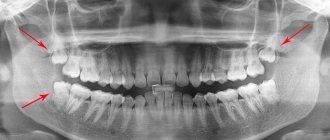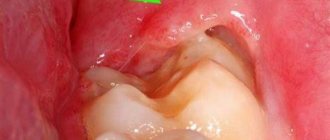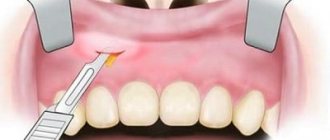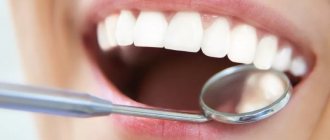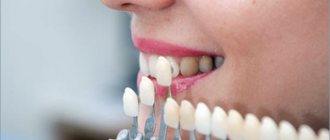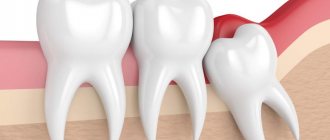Braces are a common method of correcting malocclusion and are suitable for children and adults. Before installing an orthodontic structure, the patient has many questions, one of which is whether it is necessary to remove wisdom teeth before braces. We will talk about this in the article.
In this article
- What are wisdom teeth?
- Why are braces needed?
- Is it necessary to remove figure eights before installing braces?
- Why remove wisdom teeth?
- What is separation?
- Conclusion
How to prepare teeth for braces?
The first consultation is the most important step on the path to an attractive smile. It includes several procedures that allow the doctor to gain a complete understanding of the patient's problems:
- external examination (face, posture, oral cavity);
- study of the condition of teeth, dentition, jaw bones, soft tissues;
- diagnostics, including obtaining an orthopantomogram, teleroentgenogram;
- studying X-ray diagnostic data and comparing them with visual inspection data.
At this stage, the attending physician decides what treatment measures will have to be carried out before installing the bracket system so that the correction is as effective as possible and occurs without complications. In dentistry they are usually divided into three groups:
- group A includes procedures that ensure the proper quality of treatment - for example, plastic surgery of the frenulum of the tongue and lips, if it was not performed at the stage of primary occlusion;
- group B - preserving oral health;
- in group C - those that minimize the risk of complications.
Activities in Groups B to C include identifying and treating hidden cavities and infected root canals, having your teeth professionally cleaned before braces, and finally deciding whether third molars need to be removed.
Prices for services
Extraction prices depend on the location of the unit and the complexity of the procedure. The table below shows approximate prices for such an operation.
| Unit type | Easy removal | Difficult removal |
| cutter | 700 – 800 rubles | from 1000 rubles |
| molar | 800 – 900 rubles | from 1200 rubles |
| eight | 900 – 1000 rubles | from 1400 rubles |
Complex removal means extraction, during which it is necessary to carry out additional manipulations, for example, opening the gums and applying sutures. For complex removal, the cost of the service is calculated individually.
As for separation, the cost of this service depends on the number of units that need to be processed. The average price is 500 – 600 rubles per unit.
In the video, a specialist clearly explains whether teeth need to be removed before installing braces.
Ultimately, it is the patient who decides whether to remove wisdom teeth.
Let us immediately make a reservation that when drawing up a treatment program, the orthodontist is guided not by his own desires, but by the picture obtained during the diagnosis.
Wisdom or figure eight teeth can indeed cause the development of some dental defects. But due to a number of features, the process of removing them is a very traumatic procedure. It is quite difficult for a person to part with even one “eight”, and if we are talking about two or four, not everyone will want to continue talking about orthodontic treatment. Therefore, when announcing the need for surgical intervention, the doctor takes on great responsibility and, accordingly, carefully weighs the pros and cons.
In addition, no patient’s teeth have ever been forcibly removed in orthodontist centers in Moscow. If the logical justification for this procedure seems unconvincing to you, you may well consult with one or two more specialists.
Why remove wisdom teeth before getting braces?
- In panoramic photographs of teenagers being prepared for orthodontic treatment, the beginnings of figure eights are clearly visible.
- The “prototypes” of wisdom teeth do not yet have roots and are located under a thick layer of bone, the so-called bone visor.
- The growing body of a teenager will react acutely to complex surgery. After all, you will first have to cut the soft tissue, then remove the bone above the third molar and only then extract it.
- At the end of the operation, serious tissue swelling will be observed, the child will have difficulty opening his mouth, and the temperature may rise.
The doctor does not know how problematic wisdom teeth that have already formed will become, so no one will injure adolescents by removing them before the correction begins.
A dozen years will pass, and the “eights”, which have already formed a root system, may begin to bother the patient. As an orthopantomogram shows, impacted, that is, unerupted, and therefore defective teeth can occupy a horizontal position in the jawbone. In such cases, they pose a threat to the “sevens” in front, since they cause resorption of the interdental bone septum and destroy the ligamentous apparatus that holds the teeth in the bone. Is it necessary to remove such wisdom teeth? Yes, and they are removed, even if treatment with braces is not intended.
If you leave an unerupted or not fully erupted tooth and install braces, it may happen that, having started to move outward, it will literally move the entire dentition in one or two nights, overcoming even the traction force of the orthodontic arch. The patient's time and money will be wasted.
Expected effect
When correcting the bite using orthodontic systems, tooth extraction makes it possible to speed up and facilitate the process of changing the position of the teeth.
The movement mechanism consists of the following actions:
- Due to the pressure that the device exerts on the units, the hole expands.
- The connective tissue is stretched.
- New bone cells are formed in the free area.
Thus, the units are moved to the row space that was freed up by removing individual elements.
After surgery, the main correction period is significantly reduced by about two months. This is especially true in cases where the patient has crowded teeth.
The gaps created by extraction are closed approximately six months after the start of therapy.
In some cases, after correction, the patient’s facial features change. As a result of bite correction, the face becomes more symmetrical.
Is it worth removing wisdom teeth before braces?
Orthodontists offer the removal of full teeth in several cases, which we will discuss in more detail. But quite often, for each indication, there is an alternative correction option that does not involve tooth extraction.
- Most often, the reason for removal is a discrepancy between the sizes of the teeth and jaws: either the teeth are too large or the jaw is not large enough. Clinically, such an anomaly is manifested by crowding of teeth or their protrusion, that is, excessive forward deviation, revealed when studying a teleroentgenogram. But in the vast majority of cases, the cause is deformation of the jaw, manifested in a decrease in its size. Therefore, the possibility of saving teeth by developing the jaw to obtain the necessary space should be considered.
- It is not always necessary to remove teeth when there is upper prognathia—the movement of the upper jaw forward. If the reason turns out to be its excessive size, you may actually have to part with the teeth. But with a normal size, protrusion can be caused by a problem with the cervical spine. In this case, a consultation with an osteopath will help, who will find a way to correct the positions of the cervical vertebrae and thereby normalize the position of the jaw.
- Sometimes the anomaly is manifested by a lower jaw pushed back - either normal, or increased or decreased in size. Do I need to remove wisdom teeth? Usually, removal is suggested if the aesthetics of the patient’s profile is disrupted when the jaw moves forward. With normal jaw sizes, the appearance usually does not suffer, but with excessively large or small jaws, the solution is not to remove the teeth, but to undergo more serious surgical intervention. But there must be additional, fairly serious reasons for this.
What is separation?
An alternative to removing figure eights before installing braces is the separation procedure. This method is considered more gentle and physiological for the patient. Its essence is that a thin layer of enamel is removed from the side surface of one or more teeth. This allows you to free up space in your jaw without having to remove teeth. During separation, the dentist removes approximately an enamel layer only 0.25 mm thick, which does not affect the health of the tooth, but can lead to increased sensitivity.
Separation is a relatively simple and painless procedure. Sometimes only 0.2-0.5 mm is missing to turn the tooth, and in this case, removing the enamel layer helps solve the problem. If, for such indications, the tooth is completely removed, more space will be freed up than necessary.
The advantages of separation are obvious:
- after the procedure there is no hole left that needs to be properly cared for;
- there is no risk of complications, infection of the wound, pain, as after tooth extraction;
- The procedure is performed quickly, does not require preparation, and does not cause discomfort to the patient.
Separation is carried out in different ways. The first option is to use thin abrasive strips, or strips. First, the dentist grinds the teeth with them, and then grinds the surface until smooth. Another method is separation using special wedges, which are installed between the teeth for 24 hours and free up the space necessary for the orthodontist.
Since the procedure increases the sensitivity of the enamel, the doctor will recommend remedies to reduce it.
When is it necessary to remove teeth before braces?
Sometimes there really is no alternative to deletion. Moreover, it is not the third molars that have to be removed, but completely different teeth.
Sometimes patients come for a consultation with an orthodontist with straight teeth, but a so-called “convex profile” that prevents them from even closing their lips. In such cases, the removal of “fours” and/or “fives”, first and second premolars helps to correct the situation with both appearance and bite. Removal is performed in pairs - according to indications, in one or both jaws.
Orthodontist consultation
Often, parents of children turn to an orthodontist when teeth grow unevenly. The main request is to make your teeth straight and beautiful. However, timely contact with an orthodontist helps prevent the appearance of crooked teeth. In children and adolescents, orthodontic treatment is faster and more effective due to the period of active growth of the facial skeleton, so the sooner you contact an orthodontist, the easier it will be to prevent or correct emerging malocclusions in a child. Sometimes wearing a plate helps eliminate crowding of teeth, widens the jaw, and you can do without braces.
In this case, the orthodontist discovered, in addition to the incorrect position of the front teeth, other disorders. A full diagnosis was carried out: impressions were taken, photometry, a panoramic photograph of the teeth, TRG in the lateral projection, consultation with an osteopath and speech therapist.
Please note that even at rest, when the girl was relaxed, her lips were not closed, and her front teeth protruding forward left marks and injured her lower lip.
The orthodontist's diagnosis: pronounced narrowing of the upper and lower dental arches. Deformation of the shape of the dental arches. Diastema (gap between the front teeth). Biprotrusion of the incisors (the incisors of both jaws protrude forward). The vestibular position of the lower canine on the right (the tooth is displaced to the outside) with a lack of space in the dental arch. Sagittal gap 8 mm (lack of closure of teeth). Deep bite. Midline shift.
Speech therapist's diagnosis: infantile type of swallowing.
Orthodontist O.I. Bolshova works with various orthodontic equipment - external braces, internal (lingual) braces, transparent aligners to correct the bite (Oksana Igorevna became one of the first certified doctors in Russia for treatment with aligner aligners). The orthodontist explained to the parents that in this case, treatment with braces would be most effective. Treatment will take about 1.5 years.
According to the calculation results, creating space for the correct position of the teeth and an ideal bite only by expanding the dental arches will not give a stable result, so the decision was made to remove two teeth to correct the bite (one each from above and below). Removal on one side is due to the existing displacement of the midline in relation to the face and teeth.
Commentary by orthodontist O.I. Bolshoy: “Many people express concern when an orthodontist recommends removing healthy teeth for existing orthodontic indications. An experienced doctor always focuses on calculations made in a specific situation. Even if the same doctor straightened all of one patient's teeth without extraction, another may need an extraction. There is no need to worry that there will be a gap left from the extracted tooth. As you can see in this example, the place after such an removal is perfectly covered with one’s own teeth, and not only those around you, but sometimes even the dentists themselves do not immediately notice the lack of a premolar tooth. But if you refuse to carry out the extraction, in an effort just to “shove” all the teeth into the dentition, the consequences can be the most unfavorable.”
